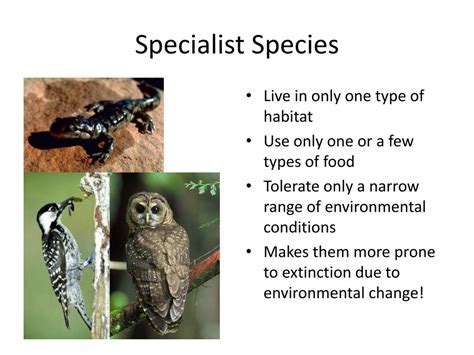In the intricate tapestry of life on Earth, a vast array of organisms have evolved to occupy specialized niches, exhibiting remarkable adaptations that enable them to thrive in unique and challenging environments. These specialist species stand as testament to the extraordinary diversity and adaptability of nature’s creations.

Characteristics of Specialist Species
Specialist species are organisms that have evolved specific adaptations to exploit a particular resource or habitat, often to the detriment of their ability to survive in other environments. These adaptations can manifest in various ways, such as:
- Morphological traits (e.g., long tongues for nectar feeding, specialized teeth for eating particular prey)
- Behavioral adaptations (e.g., migration patterns, social hierarchies)
- Physiological adaptations (e.g., tolerance to extreme temperatures, ability to metabolize specific compounds)
Examples of Specialist Species
1. Koalas (Phascolarctos cinereus)
- Habitat: Eucalyptus forests of Australia
- Specialization: Feeding exclusively on the leaves of eucalyptus trees, which are toxic to most other animals due to their high concentration of tannins
2. Vampire Bats (Desmodus rotundus)
- Habitat: Tropical and subtropical regions of the Americas
- Specialization: Feeding on blood from warm-blooded mammals, requiring a unique digestive system and sharp teeth to puncture skin
3. Giant Pandos (Ailuropoda melanoleuca)
- Habitat: Temperate forests of China
- Specialization: Feeding almost exclusively on bamboo, a low-nutrient food source that requires a specialized digestive system and a slow metabolism
4. Sea Otters (Enhydra lutris)
- Habitat: Coastal waters of the North Pacific Ocean
- Specialization: Preying on shellfish, such as sea urchins and crabs, using their thick fur to insulate themselves in cold waters
5. Symbiotic Fungi (e.g., Mycorrhizal Fungi)
- Habitat: Soil
- Specialization: Forming mutually beneficial relationships with plants by providing nutrients in exchange for carbohydrates
6. Xerophytes (e.g., Cacti)
- Habitat: Arid environments
- Specialization: Adapted to conserve water through thick, waxy cuticles, reduced leaves, and deep root systems
7. Deep-Sea Anglerfish (Melanocetus johnsonii)
- Habitat: Depths of the ocean (>1,000 m)
- Specialization: Lures prey using a bioluminescent lure attached to a modified dorsal fin
8. Bioluminescent Jellyfish (e.g., Aequorea victoria)
- Habitat: Marine environments
- Specialization: Emits light as a defense mechanism and for communication
Consequences of Specialization
While specialization can provide significant advantages in certain environments, it can also limit an organism’s ability to adapt to changing conditions or exploit other resources. Specialist species are more vulnerable to:
- Resource Depletion: If their primary resource becomes scarce or unavailable, they may face a population decline.
- Environmental Changes: Climate change, habitat loss, and pollution can disrupt their specialized adaptations.
- Competition: Generalist species, which can exploit a wider range of resources, may outcompete specialists in environments where resources are shared.
Importance of Specialist Species
Despite their potential vulnerabilities, specialist species play crucial roles in ecosystems:
- Ecological Stability: They maintain biodiversity by occupying unique niches and reducing competition within ecosystems.
- Ecosystem Services: Some specialists provide valuable services, such as pollination, seed dispersal, and nutrient cycling.
- Scientific Insights: Studying specialist species can provide insights into evolutionary processes and the complexities of ecological systems.
Examples of Specialist Species in Action
Specialist species have inspired numerous innovations and applications in various fields:
- Biomimicry: Velcro was inspired by the tiny hooks on the plant burrs that attach to animal fur.
- Medicine: The venom of the Gila monster has led to the development of a new class of pain medications.
- Agriculture: The use of mycorrhizal fungi has improved crop yields by enhancing nutrient absorption.
Conclusion
Specialist species are a testament to the extraordinary diversity and adaptability of life on Earth. Their unique adaptations have enabled them to thrive in challenging environments, contributing to the delicate balance of ecosystems. Understanding and conserving specialist species is essential for maintaining a healthy and resilient planet.
